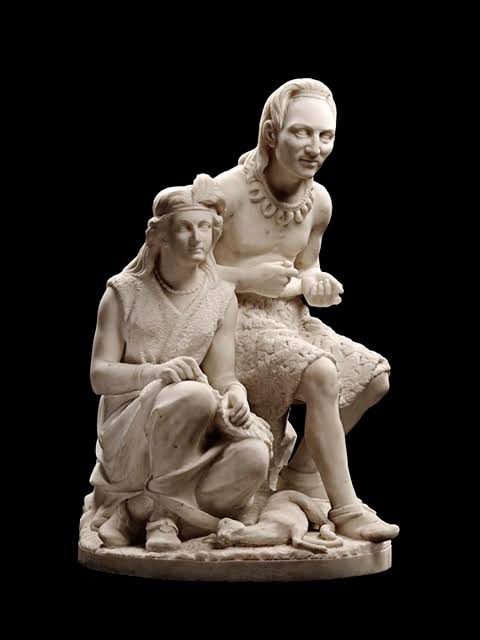“Some praise me because I am a colored girl, and I don’t want that kind of praise,” she said. “I had rather you would point out my defects, for that will teach me something.” – Edmonia Lewis:
It’s no news, black creatives not being given due recognition, thankfully the narrative is changing by the day.
Pioneering Sculptor Edmonia Lewis, the first African American, and Native American sculptor to achieve international acclaim through her neoclassical works exploring religious and classical themes on January 26 was honored by the United States Postal Service with her postage stamp in a special ceremony at the DC gallery.
The stamp, the 45th in the U.S. Postal Service’s Black Heritage series, issued Jan. 26 at the Smithsonian American Art Museum in Washington features a painted portrait of Edmonia inspired by an Augustus Marshall photograph taken between 1864 and 1871 while Lewis was in Boston, the USPS said.
“It’s fitting that she should be commemorated with a postage stamp because so much of what we know most vividly about her we know from letters that people were close to her wrote,” said Marilyn Richardson, a Massachusetts-based art consultant.
Although forgotten for decades, many thanks to a discovery of a bust of Christ created by Edmonia Lewis (1844-1907) the first female black American in her studio in Rome in 1870, fresh interest was sparked on the world stage.
Lewis, one of the most significant sculptors of the 19th century, with her most significant work being The Death of Cleopatra, battled multiple obstacles including sexism and racism to become a force in the male-dominated industry.

Edmonia Lewis, The Death of Cleopatra
Lewis broke through barriers and rewrote the definition of what female and minority artists could accomplish. “It was very much a man’s world,” says the museum’s curator Karen Lemmey. Lewis, she says, “really broke through every obstacle, and there’s still remarkably little known about her. . . . It’s only recently that the place and year of her death have come to light—1907 London.”
Lewis’s first work seen publicly was a medallion, advertised for sale early in 1864, that featured the head of militant abolitionist John Brown.
Born in 1844 in Greenbush, New York, to a Haitian American father and Chippewa, mother who died before Lewis was 5, she was raised by her mother’s family until she was 12. In 1859 at age 15, she got enrolled at Oberlin College in Ohio by her older brother, who had become a successful gold miner in California, the school was one of the few to admit African Americans. Subjected to racism and sexism, it all turned sour when Lewis was accused of poisoning two friends in 1862, although the charges were dismissed, mob action was taken by white vigilantes and she was left for dead. A year later she was accused of theft, again she was acquitted owing to lack of evidence. In 1863, she left Oberlin for Boston, again with her brother’s assistance.
In 1865 she arrived Rome where she created The Death of Cleopatra, her most powerful work which saw more than four years in the making.
“Rome becomes a place where she can truly not just discover herself but become everything she always dreamed to be,” Lev told Catholic News Service. “The limitations she felt and were real in many ways in the U.S. were not limitations (in Rome)” Art historian Elizabeth Lev who grew up in Boston said.
Lev describing Lewis’ work said it reflected her mixed ancestry. Her sculptures were of notable abolitionists as well as figurative images. Part of her collections include her 1874 piece portraying of Hagar, a maidservant to Sarah, Abraham’s wife, her 1875 sculpture depicting Moses in an imitation of Michelangelo’s 16th-century statue of the man who led the Israelites out of oppression, busts of abolitionists John Brown, who led slave rebellion at Harper’s Ferry, West Virginia among others.

Edmonia Lewis, Old Arrow Maker, 1872
Part of Edmonia Lewis’ collections can be found at the Smithsonian American Art Museum and the Howard University Gallery of Art in Washington, as well as church institutions in the U.S. and Europe, however many of her work, has been thrown into obscurity. Her most significant work, The Death of Cleopatra, is posed at the museum’s third floor in the Luce Foundation Center.
Lewis died in London in 1907 at age 63. She never married and had no children. She is buried in St. Mary’s Roman Catholic Cemetery in the city’s borough of Brent.



